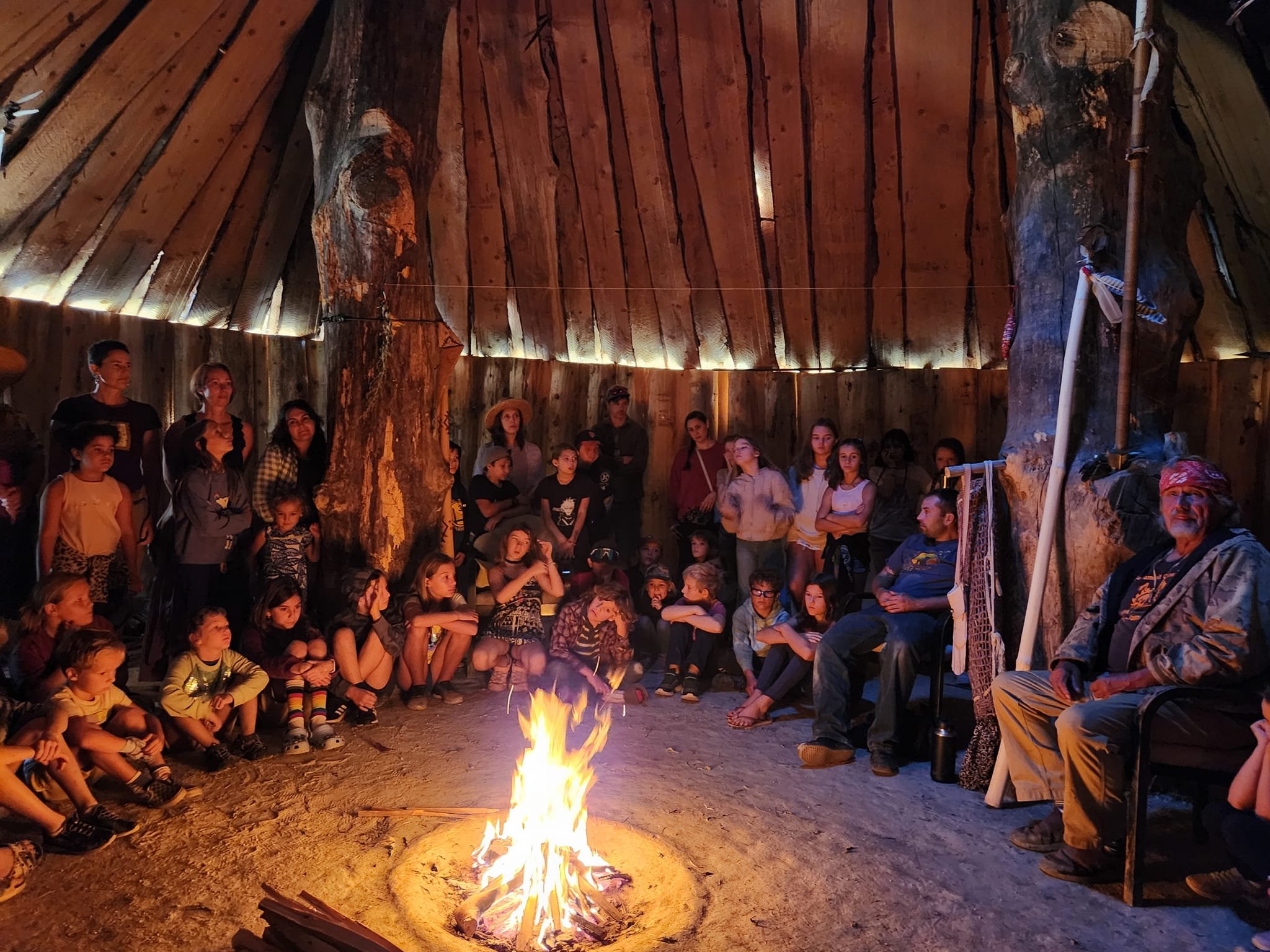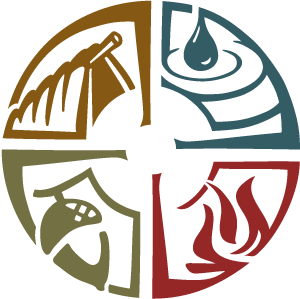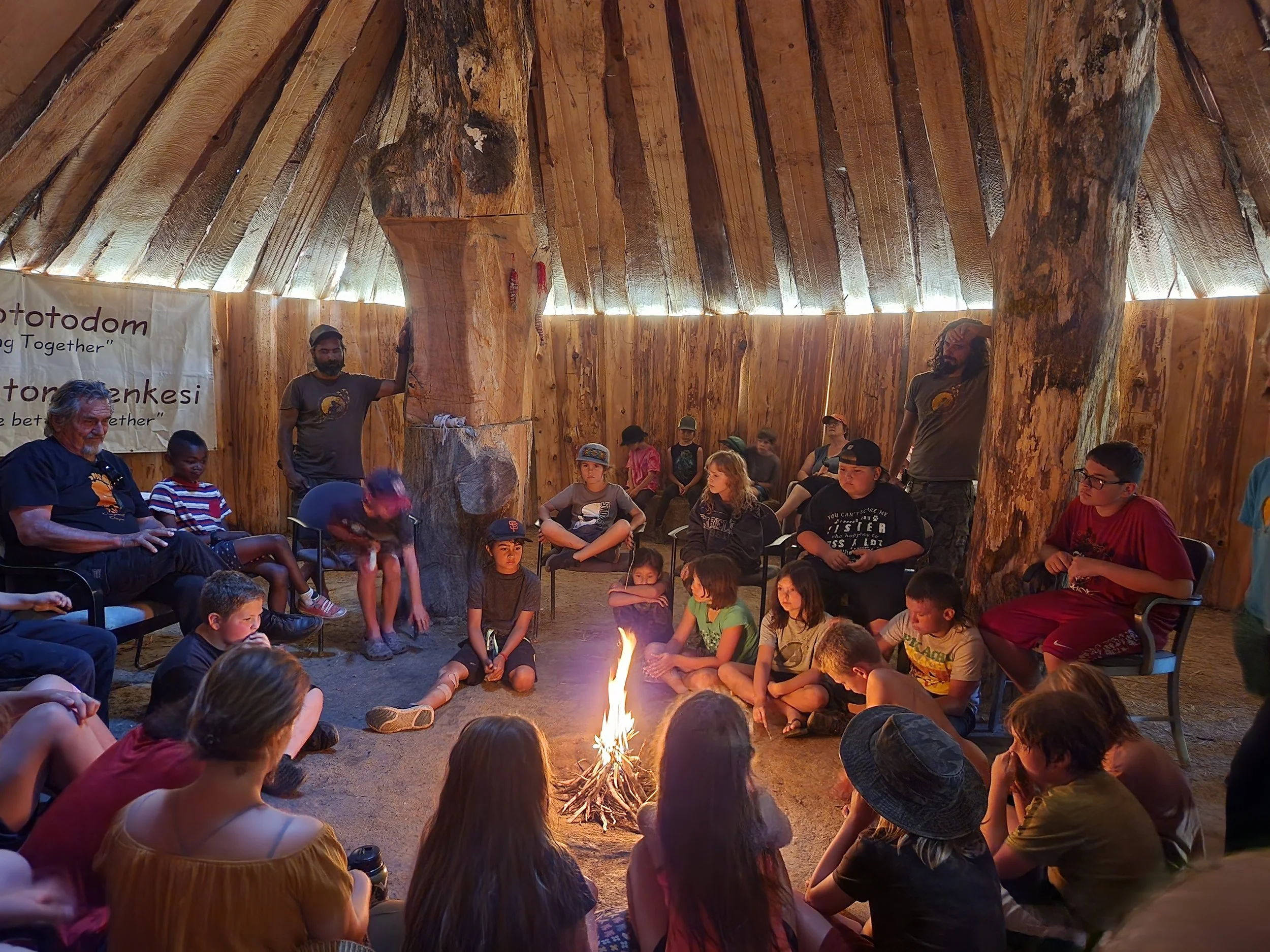
California Indigenous Partnership
California Partnership
4 Elements Earth Education and the Siakumne Tribe are in partnership with the common goal of educating ourselves and our youth.
In this endeavor 4EEE has agreed to the entire Burton Educational Preserve to be sanctioned by the Siakumne Tribe and thus the entire ancient Village site to continue as it had under the Indigenous Land Stewardship ways for thousands of years.
Land Use Agreement between 4 Elements Earth Education and the Siakumne (Tsi Akim Maidu) Tribe
Mission Statement and Land Stewardship Plan:
Pata Panaka is a historical village, active cultural learning center and a place to do our ceremonies without interruption. The Burton Educational Preserve, overseen by 4EEE teaches children how to become effective land stewards. Our key issues center around the protection of all our sites; sacred, burial, village, gathering and harvesting, and habitat for birds, animals and fish. Land Stewardship using Traditional Ecological knowledge (TEK) involves taking care of the land. This philosophy is that we take care of the land and the land tales care of us. This belief is that all things are our relatives: land, trees, plants, air, water, fire, wind, animals, and fish. They are respected and cared for in the same ways as our family members are cared for and in turn, take care of us. We must listen to the land, and it will tell us what needs to be done, how to do it, and when.
Because of dams and reservoirs on our creeks and rivers, we have lost our salmon, eels, turtles, river otters, and many other relatives, We have lost the fishing villages, ceremonies, songs and way of life that went with the gathering of these fish, animals, plants, and medicines. Depending on the personality of the land, implementation of the stewardship plan may vary, but the key issues will remain the same,
4EEE and the Tsi Akim Maidu Tribe are in partnership with the common goal of education ourselves and our youth. In this endeavor 4EEE has agreed to the entire Burton Educational Preserve to be sanctioned by the Tsi Akim Tribe and thus the entire ancient Village site to continue as it had under the Indigenous Land Stewardship ways for thousands of years.
Don Ryberg,
Tribal Chairman, Tsi Akim Maidu Tribe (Siakumne, Loc-lum-ne, Sa-cum-na, pre 1851 names)
Rick Berry,
Executive Director 4EEE

Restoration of Burton “homestead”(name changed to Burton Educational Preserve, as Homestead being offensive to Native folks)The 13+ years 4E has been teaching Fox Walkers we have witnessed the rebuilding of an ancient village site. There are now three Dance Grounds, the first now being used by Fox Walkers and for Indigenous Peoples Days camping area in October. There is now an open field that is mostly covered in grasses, some native and some non-native species. The second dance ground is now the center of the village, near the Bark House, Dance House, and Sweat House. The Pole with the eagle on it was a Grandfather Cedar that the Land Trust cut down in 2011. The Third Dance Ground was recently made, and more water catchments and second sweat house. In 2015 or so there were around 100 dead Ponderosa Trees taken down on the top knoll of the land “survival camp” and now there is a thick meadow with mostly blue wild rye / mix of blue crest complete with thriving vole city.Currently a large population of Acorn Woodpeckers, Grey Squirrel, a mix of Fox and Coyote and Coy Coyote.Still many woodrats and old Woodrat stick homes, a few Douglas Squirrels seen. Jack-Rabbit, skunk, weasel, occasional bear, mountain lion, a small herd of 14 black tail deer or so on and off property, a healthy spectrum of song birds, woodpeckers, ravens, crows, hawks and owls. Occasional ducks, blue herons. With more small open grassy areas populations are up as the voles, mice, shrews have habitat and everything else eats them. Also trimming of thick woods creates healthier sun dappled areas of biodiversity, native grasses, hawks able to fly and hunt in the woods. With the addition of small ponds, the insect life has increased, as well as aquatic plants, frogs, and bluegill fish.Burton Homestead—abandoned landscape for 20-30 years, after cattle grazing, mining, logging, starting in the 1850’s. The place looked like to moon at one point in history. The springs here were used for long box –water mining mixed with mercury and arsenic, that created mining tailings of rocks, debris in rows all over land below the water sources. (many trees growing on top of this waste land have died with recent droughts) When 4E started programs here in 2010 the woods were very thick and fire danger extreme.The reason we are defining this as Re-Indigenized is that 4E is sanctioned by the Tsi Akim Tribe through their Traditional Ecological Knowledge. As a non-profit organization that teaches Earth Skills, 4E is intrinsically bound to honoring Indigenous Peoples as this is where we gained our teachings from. We are striving to evolve our non-profit to align with Indigenous Values and under their leadership –not under the leadership of State / Fed mandates that have historically destroyed this land and attempted to exterminate the original peoples.What a better way than to restore land with creating ceremonial grounds. Every ceremony that takes place on Pata Panaka is healing the people that attend as well as healing the land—including all the animals, plants, water, stones (-as stated in the above TEK ). The ceremonial aspect may be misunderstood by the well educated environmentalist. Ceremonies, that all our Ancestors did, come from pacts / agreements, with the land and life—come from how to create the healthiest environment from thousands of years of making relations and knowing that we are a part of Earth Mother. Ceremonies many times include hides from animals, feathers from birds, material from plants, clean water, stones…. As in the case with making a regalia item –one needs to know where to find it, actually go into nature and harvest and make into dance regalia. Well, is the material life even still there ? Has it been taken care of, has someone been tending it? The few Elders left that know how to run the Ceremony guide the younger Elders, who in turn guide young leaders, who are teaching the youth and can now begin to give direction to what is needed for the ceremony. Now we are giving need to our youth to go into the woods to care of the “maiden hair fern to make baskets”, “the maple trees for the inner bark” etc… this is one of the direct relations the Fox Walkers have with the Tribe and the hands on Earth Skills we do with the youth. Then when the regalia is Danced it represents it Self as our teacher, healer, guide. The more folks in the community who are involved with the Ceremony, the more powerful and healing relations with our entire Ecological system.Ongoing Restoration:
35 Bails of straw being spread on steep areas- water bars and charcoal, wood chips, straw
Some areas of steeper cuts will be hydro seeded with native seed mixture
Seed, native on most areas, also erosion mix on more traveled areas (clover, fescue, bluegrass-mix)
Trees, bushes, new tress in the planning, clearing ladder fuel in tick areas, native and also food bearing trees that are native and non-native.
Tending the Black Oaks, Sugar Pines, Orical Oak, cutting back some Live Oak, taking down dead Ponderosa, continued removal of scotch broom and invasive blackberry (some blackberry we contain in an area*)
Propagating other native plants and trees- Alder, Grey willow, maple, service berry, cottonwoods, black oak, bring back angelica root, and other native medicinal plants.
700 feet of pressurized water line installed from “city water” with 6 house bibs for fire suppression and for watering new seeds, and keeping area greener in the summer.
New 1100-gallon water tank installed to hold ditch water to feed new water catchments and create more riparian plant and tree zone on west side of land.
Continued work with expert advice from Matt Berry, Botanist, on processed based ecological restoration as well as certified controlled burning alongside of other Indigenous Tribes (Karuk-Hoopa-Yurok examples)
Continued work with Sierra Harvest in replanting.
Another very important aspect of our partnership with the Tribe and their Traditional Ecological Knowledge, is how we teach that everything in Nature is our relative. Below is a story of how we treat our relatives and asking permission to share with them.
Last winter we wanted to get rid of some of the blackberry near Pond Camp. Don came an started some tractor work and ended up making the pond larger so the kids could have more places to swim in the summer. We ended up putting a new deck over part of the water and finally created our water feature as it pours off a wooden flume into the pond. As the summer came the kids had a blast swimming and jumping off the dock. However it was murky, but after we got back from our Wilderness Trip to the Smith River, the pond had settled and you could finally see the bluegill fish and many baby bluegill fish swimming in the clear water.
Jorge, an old friend, originally from Argentina, was working with the younger children and would sit and have breakfast on the dock. He started feeding this fish a little bit and got to know them like they were his pet fish. It was something to see and he got me to feed them and sure enough there would be about 10 larger adult bluegill and about 40 baby ones that would come right up to you. It reminded me of the story of the local Maidu speaking people and how they had a pet trout in a pool of clean cold water just up the hill—cement hill. The sad part was that some kids decided take the fish and the local tribal folks lost their favorite pet trout.
So, Jorge and I got to talking and decided that the fish in this pond need to be asked permission to share their home.
Jorge and I brought the topic up as a “council” to our groups of youth. We started with having them go say hello to the fish and ask them permission if we could swim in their home. Well, the little kids met up in their own council and figured out that the fish will have their council tonight and let us know tomorrow.
The next day the youngest group met with the older groups and gave their account: “that the fish would share part of the pond with us, but we need to first ask the “Chief “ what he thinks”. So, the kids went to ask Don what he thought about it. The youngest one asked Don: can we have permission to swim in the fish’s home? He agreed that yes, you could share part of the pond with the fish. And so, the rest of the summer we could see the fish in the clear water on their side of the pond near the dock and the kids could jump off the log across the pond and cool off in the summer heat.





